7
Abigail Cummings, Jillian Forauer, Chris Harvill, Vinh Tran, and Sai Vadlamudi
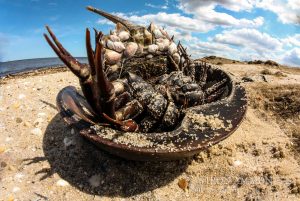
Chapter Summary
The horseshoe crab is one of the oldest extant species in history, and even predates the dinosaurs. They only now are facing the threat of being endangered. It’s many unique characteristics are vital to various outlets, from ecology to medicine, ecotourism, and many more. There is no doubt that xzhorseshoe crabs are integral to our society. But in recent years, their population numbers have taken a dive due to many different factors, one of the biggest being human exploitation. Various conservation efforts have slowed this decline. However, much more must be done to reverse this population trend.
If you have ever wandered down the coastline of the Atlantic, the odds are high that you have at one point walked by a horseshoe crab. You may have seen its small round shell, never realizing that once you turn it over, you see a completely different creature with many legs and pincers. When you take the opportunity to see beyond the shell, there is a lot more than meets the eye in the life of a horseshoe crab. Although it is a mundane and peaceful creature, the Atlantic Horseshoe Crab has its share of environmental threats which contribute to its rich story. In this chapter, we will discuss not just what these prehistoric creatures have done for their natural ecosystem as well as humans, but what we can do to protect this relic of the past for many more years to come.
The Life History of the Atlantic Horseshoe Crab
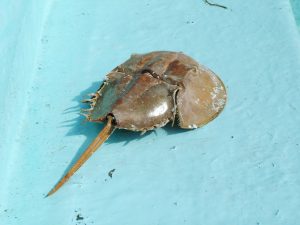
The Atlantic horseshoe crab (Limulus polyphemus) is a peculiar species with a somewhat alien-like appearance (Figure 1, 2). Its phylum and class are identified as Arthopoda and Meristomoata Dana respectively (Walls et al. 2002). Despite its title as a “crab”, its phylum relates more to spiders and scorpions rather than actual crustaceans, and its class is one used for defining marine species that have been around for around 200 to 500 million years (Walls et al. 2002). As suggested in its name, these horseshoe crabs (apart from their relatives in the Southeast Asian Pacific) live along the Atlantic coastal range from Maine to Florida, and some in regions along the Gulf of Mexico and Yucatan Peninsula (Smith et al. 2016). Horseshoe crab life cycles are unexpectedly long with a lifespan of up to 20 years. Most reach maturity at the ages of 8-10, with females taking longer to mature due to their larger sizes at maturity and sexual dimorphism (Walls et. al. 2002).
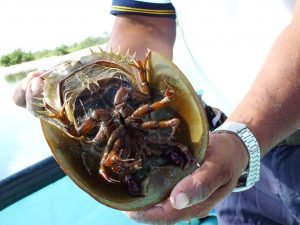
These crabs are predators to mostly shellfish, using their pincer-like legs to dig and crush any hard shells of varying types of clams, mollusks, and mussels (US FWS 2006). Since horseshoe crabs do not have teeth, they use their claws to crush their food before passing it into their mouths (NWF n.d.). Besides these species, horseshoe crabs may feed on algae, especially as juveniles (Carmichael et al. 2009). As for species that prey on the horseshoe crab, different types of shorebirds, fish, and arthropods prefer to eat horseshoe crab eggs, larvae, and juveniles since they are less difficult to eat than adult crabs (Smith et al. 2016). Horseshoe crabs typically remain in intertidal regions and only move to calm shorelines for reproduction and laying eggs (Smith et al. 2016). Males typically latch onto the hindbody of females as the females move toward intertidal areas to release eggs (Figure 4). Some males may also fertilize eggs if they migrate to shores from ocean waters and are considered to be unattached, but this contributes to their ability to generate biodiversity as a species (Botton and Loveland 1989). Unfortunately, about 10% of crabs may become stranded on beaches during the spawning season and perish due to their inability to return to the water (Figure 1) (Botton and Loveland 1989). Although this species may seem like a simple marine animal with an unusual appearance, several of its unique characteristics and activities, such as its unique “blue blood” and spawning cycles, are surprisingly vital for other facets of ecological or human activity.
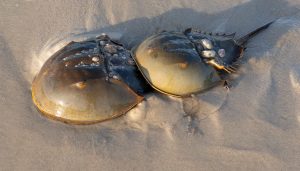
Horseshoe Crabs Impact a Variety of Industries and Surrounding Species
The first, and arguably most important role for horseshoe crabs, is within the local environment. Since this species plays a major role as a food source for some species and a primary predator for others, human-derived threats to horseshoe crabs also impact surrounding species in the Atlantic coastal ecosystem. Horseshoe crabs are mainly primary predators for different types of benthic invertebrates, such as the razor clam, macoma clam, surf clam, blue mussel, and wedge clam, which makes them a key factor in controlling the local population sizes of each of these species (Walls et. al. 2002, Krisfalusi-Gannon et al. 2018). In terms of predators, migratory bird species, such as the American red knot, land on horseshoe crab spawning grounds to eat recently released eggs. This feasting is essential to the birds because the horseshoe crab eggs provide a primary energy source necessary for the birds to complete the final stretch of their migration (Fisheries NOAA 2018). Overharvesting and habitat degradation of horseshoe crabs heavily reduces crab populations, and thus decrease the population of red knots. This can be seen from 1989 to 2008 where the observed red knot population dropped significantly from 100,000 to 15,000 (Rafferty n.d.)(See more in Box 1 – Red knots and horseshoe crabs: Two vulnerable species make for an unsustainable relationship).
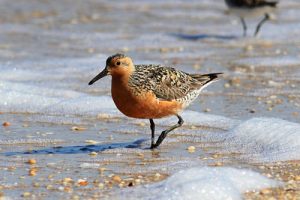
Box 1 – Red knots and horseshoe crabs: Two vulnerable species make for an unsustainable relationship
The red knot is a migratory shorebird and can be found on every continent except Antarctica; however, their North American population has declined sharply due to the overharvesting of horseshoe crab eggs (Shrading 2016). These birds feed on the horseshoe crab eggs in order to survive their 9,000-mile migration from wintering grounds in South America to the breeding grounds in the Arctic. These birds migrate at the same time each year, landing in places like Delaware Bay just as the horseshoe crabs are beginning to spawn. However, horseshoe crab populations have been on the decline since the late 1990s due to overharvesting as bait for commercial eel and whelk industries, as well as for their highly prized blood used in biomedical testing. Local and state fishery and wildlife services are pushing for alternatives for both cases to help not just the horseshoe crab population, but the red knot as well (Shrading 2016).
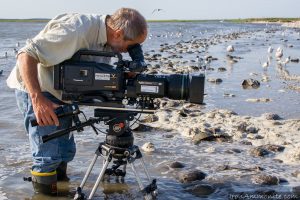
Horseshoe crabs are a very important species also in terms of tourism since many restaurants depend on the effect that horseshoe crab eggs have on the arrival of shorebirds, and as a result, tourists (Figure 6). Peak spawning season for horseshoe crabs is from May through June, which marks the beginning of the summer season in some of the most popular horseshoe crab spawning sites in the Atlantic, such as Cape Cod and Delaware Bay (Smith et al. 2016). People come from all over the world to see the shorebirds landing at these sites. One economic study found that 30 million dollars was generated by shorebird watching in southern New Jersey alone. (Rafferty n.d.).
The horseshoe crab is not only vital to society in terms of tourism, but also for the biomedical industry. These crabs have a special compound within their blood called limulus amebocyte lysate (LAL)(PBS 2008). This is used very heavily within the biomedical industries in LAL tests which determine if a sample is contaminated with endotoxins, and the process of harvesting the blood itself generates over $50 million in revenue each year (PBS 2008). This itself is a huge industry, but every company that produces medicine, biomedical implants, and prosthetics relies on LAL. This is because every one of these drugs and devices must pass a LAL test to follow FDA regulation (PBS 2008). Horseshoe crabs are “bled” in biomedical labs to harvest their blood which contains high amounts of LAL (PBS 2008) (See more in Box 2: Crabs and COVID-19: The molecular miracle of horseshoe crab blood).
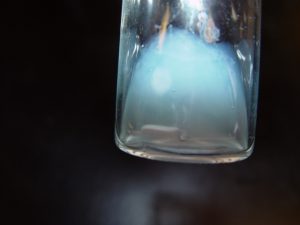
Box 2 – Crabs and COVID-19: The molecular miracle of horseshoe crab blood
Biomedical bleeding of horseshoe crabs is the process of collecting the hemolymph, or the blood from horseshoe crabs. Blood is collected by puncturing the cardiac sinus and continuously taken until a clot forms, preventing further collection (James-Pirri et al. 2012). It is estimated that about 25% of a horseshoe crab’s weight is from its hemolymph (Hurton et al. 2005), and typical biomedical extractions taken each year are from over 600,000 crabs (Dykstra 2020). It is the amebocyte cells within this blood that is the vital resource needed for LAL tests. The potency of current LAL tests for bacterial toxins makes horseshoe crabs a vital resource for research purposes and for the safety of all vaccines and other injectables (Sandle 2015).
FUN FACT: The “blue blood” of horseshoe crabs is blue due to the presence of hemocyanin, which is similar to hemoglobin— the protein that makes human blood red (James-Pirri et al. 2012)LAL’s primary ingredient is amebocytes, or blood cells, from horseshoe crabs. When broken down, “limulus” is the species from which the product is derived, “amebocyte” is the type of blood cell taken from the horseshoe crabs, and “lysate” is the product formed when cells are broken down for their contents. LAL functions in horseshoe crabs as a potent clotting agent in response to lipopolysaccharides (LPS), also known as endotoxin, which is present in gram-negative bacterial cell walls (Sandle 2015). When endotoxin is detected by the amebocytes in the blood, the blood immediately prevents further infection through the release of coagulogen, a protein in horseshoe crab blood cells that forms coagulin gel in response to endotoxins (Sandle 2015). In humans, the presence of endotoxin triggers an immune response that can be as severe as sepsis, which is when an infection triggers organ damage and further immune system impairment (Rietschel et al. 1991). It’s estimated that 11 million people die from sepsis each year, and 80% of these cases are caused by the toxin from gram-negative bacteria for which the LAL test is made (Tinker-Kulberg et al. 2020). This demonstrates the incredible impact LAL tests have made to improve the safety of injectables.
Since LAL is vital for testing injectables for safety and biocompatibility, the global COVID-19 pandemic and the development of the COVID-19 vaccine made horseshoe crab harvests essential and even more relevant. Considering all the COVID-19 vaccines, there was a concern that there would not be enough LAL tests available to properly test all COVID vaccines for safety. However, the concern was squashed by the chair of the Horseshoe Crabs Advisory Panel to the Atlantic States Marine Fisheries Commission. The number of horseshoe crabs harvested for their blood in the span of 3 days would provide enough LAL to test 5 billion COVID vaccines (Motsinger 2020). Imagining a world in which this was not the case is terrifying, for both humans and horseshoe crabs. If not for recent success with conservation strategies and strict regulations set on harvest numbers in the Atlantic region, fisheries could have inflicted irreversible harm on this invaluable species.
The COVID-19 pandemic and the application of horseshoe crab LAL in vaccine development illustrates the need for humans to protect and conserve horseshoe crabs. The blood that has saved horseshoe crabs from wounds or infections for the past few hundred million years could potentially save us humans from similar infectious agents for as many years to come.
The final major economic sector that targets horseshoe crabs is the fishing industry since harvesting levels are the most impactful variable that determines the overall population health of horseshoe crabs. Horseshoe crabs are specifically used as bait for catching eels and conch. While this industry is much smaller and has been declining their use of these crabs, it still is a threat to their population. Between 1850-1920, over 1.5 million horseshoe crabs were harvested annually for fertilizer and livestock feed (ASMFC 2019). However, this practice is no longer used and was replaced with commercial harvests for fishing bait in the mid to late 1990s (Maloney 2018). High harvest levels after this turning point led to greater population declines (Maloney et al. 2018). For example, the need for bait in whelk fisheries likely spiked horseshoe crab harvest in the 1990s, with a peak of nearly six million pounds in 1997 (ASMFC 2019). In the early 2000s, conservation efforts brought that decline to a halt, and recent stock assessments show that in some regions, the horseshoe crab populations seem to be recovering (Goodrow and Procopio 2021). In more recent years, the reported coastwide bait landings remained well below the established fishing quota at 1.59 million crabs, while in 2018 the annual harvest total only reached 658,589 crabs (ASMFC 2019). With the different ways that horseshoe crabs affect the economy and environment on both a local and worldwide scale, the dangers posed to their declining population are very concerning.
Threats to the Atlantic Horseshoe Crab and Conservation Responses
Unfortunately, humans have been contributing to species habitat loss which has disrupted many horseshoe crab populations. Since horseshoe crabs spawn in bay areas and tidal zones of beaches, any construction or commercialization of the Atlantic coasts poses a threat to the success of thousands of horseshoe crab eggs in the spring and summer months. Boating in the waterways surrounding the beaches where horseshoe crabs spawn prevents horseshoe crabs from accessing beaches before they can even spawn (Moore-Perrin et al. 2007). Beyond blockages of waterways, commercial beaches and boardwalks have higher foot traffic in warmer months which interfere with horseshoe crab spawning periods. Experts on horseshoe crabs on the Atlantic coast claim that the biggest threat to horseshoe crabs is habitat loss. There is erosion of suitable habitats and breeding areas due to the increased interest in developing coastal land (Berkson et al. 2009). Although harvesting horseshoe crabs for commercial and biomedical purposes may reduce the horseshoe crab population, there are many species management regulations in place to control populations (ASMFC 2019). However, there are no management practices to prevent the degradation of land and ecosystems by commercial development (Berkson et al. 2009).
Horseshoe crabs are currently listed as “vulnerable” and decreasing in population globally, according to the IUCN Red List. But, continued efforts to protect the Atlantic-specific species have increased in number and greatly improved in effectiveness over many years of dedication (Smith 2016). Starting from 1998, the Atlantic States Marine Fisheries Commission implemented an “Interstate Fishery Management Plan” to preserve the declining Atlantic horseshoe crab population, including regulations requiring states to identify horseshoe crab habitats, threats to the species as a whole, and the methods needed to protect horseshoe crabs from threats of overharvesting and habitat degradation (Schrading et al. 1998). The most significant conservation response has been seen with general fishing harvest regulations for bait along with a smaller effort for biomedical purposes as well (ASMFC 2019). In 2004, bait harvesting methods were regulated to help conservation efforts in Delaware Bay to prevent migratory shorebirds, like the red knot, from further diminishing horseshoe crab populations. In 2006, bait harvesting was limited to only 100,000 male crabs with a delay in the harvest season to allow for more reproduction in the spring months (ASMFC 2019). In response to these conservation plans, crab populations have been experiencing some population increase in areas with management plans in place, while in 2015, conservation groups also listed the red knot as an endangered species in the U.S., which also resulted in further protection for horseshoe crabs. These efforts have done well to allow population recovery: Atlantic horseshoe crab population has nearly doubled in size from an estimated 1.4 million crabs in 2014 to just over 3.3 million in 2019 (Swan et al. 2019). Looking at the overall effort on regulating unsustainable overfishing and the population response specifically for the Atlantic species, future prospects seem to be very promising for this strange-looking crab’s future.
However, while these conservation efforts have been put into motion in recent years by heavily addressing unsustainable practices, some regions still continue to decline despite protective regulations in place (Smith et al. 2016). Most areas of concern, like the coast of Florida and the Gulf of Mexico, have limited data as to why these population numbers continue to decrease, but it is suspected that the main cause is the continued habitat degradation from land development in surrounding regions (Smith et al. 2016). Since there is limited evidence applying this indirect threat, regulations for land development methods that negatively impact horseshoe crabs have proven to be difficult to implement (Smith et al. 2016).
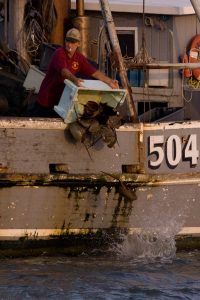
In terms of the impacts of the biomedical bleeding industry on horseshoe crab health, there are negative effects, although the process itself is considered non-lethal. Specific studies found that protein concentration, a common indicator for health, was lower in bled crabs than control crabs indicating that there are negative impacts on overall crab health (James-Pirri et al. 2012). Additionally, although the majority of horseshoe crabs are released after the bleeding process (Figure 8), there are negative impacts on the mating abilities of the crabs, thus impacting reproduction and population growth over time (Owings et al. 2019). Most harvesting companies and LAL manufacturers report that less than 3% of crabs die because of this process, while many recent studies disagree, as their estimations lie between a 15-30% mortality rate for the crabs (PBS 2008, Maloney et al. 2018).
There are new studies aimed at improving the conservation of horseshoe crabs by finding alternatives to traditional harvesting and bleeding for biomedical purposes. Many grants have been sponsored by the National Science Foundation to help promote the well-being of horseshoe crabs and find better bleeding procedures for biomedical purposes (Dellinger 2017). A current alternative that exists today is a “laboratory synthesized recombinant Factor C” (rFC) assay, which has the same endotoxin detection ability that resides in horseshoe crab blood (Maloney et al. 2018). The use of rFC has already been endorsed by the U.S. FDA and the European health ministry since 2012 as a result of its equal or even improved effectiveness in comparison to horseshoe crab blood (Maloney et al. 2018). Although this product is already commercially produced and accepted, it has hardly become widespread for LAL test use due to pharmaceutical companies’ hesitation to switch from horseshoe crab blood, since the potency and effectiveness of the LAL test are much more reliable than the rFC assay (Maloney et al. 2018). If companies are convinced to convert from LAL to rFC over time, a substantial stressor on current horseshoe crab populations would be removed as a result. While it is unclear whether or not further protective efforts will be implemented to allow this ancient organism to thrive, along with the many other species reliant on its presence, only time and continued dedication in conservation will tell in the future.
There are more alternatives to help horseshoe crab populations in the biomedical industry beyond just finding a molecular alternative for the LAL tests. Techniques are emerging to replace traditional horseshoe crab harvests from the ocean. A recent study suggested that alternatives to harvesting horseshoe crabs by growing the crabs in aquaculture would eliminate the need for harvesting new horseshoe crabs every year (Tinker-Kulberg et al. 2020). Only 45,000 crabs in aquaculture could provide the number of LAL tests needed for the biomedical and pharmaceutical industries, and analysis of the LAL tests from aquaculture suggests significantly more potent enzymatic activity due to the freshness of the collection (Tinker-Kulberg et al. 2020). Perhaps in the next few years, aquaculture will be accepted as the main source of horseshoe crabs and their blood instead of wild-caught crabs.
Next time you walk down a beach on the Atlantic, perhaps you’ll encounter another horseshoe crab. But maybe this time they could be turned over, unable to flip over, and stranded. After knowing their story and how valuable they are to keep us as humans healthy and their ecosystems balanced, maybe you’ll take the chance to flip the crab back over to return to its home in the sea.
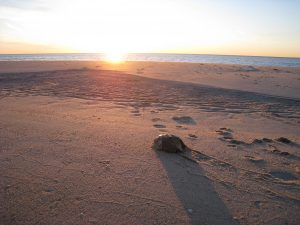
References
Atlantic States Marine Fisheries Commission (ASMFC) 2019. ASMFC stock assessment overview: Horseshoe crab [Internet]. [accessed 1 March 2021]. Available from: http://www.asmfc.org/uploads/file/5ccae597HSC_StockAssessmentOverview2019.pdf
Berkson J, Chen CP, Mishra J, Shin P, Spear B, Zaldívar-Rae J. 2009. A discussion of horseshoe crab management in five countries: Taiwan, India, China, United States, and Mexico. In: Tanacredi J, Botton M, Smith D. (eds) Biology and Conservation of Horseshoe Crabs. Boston, MA: Springer. p 465-478. Available from: https://www.horseshoecrab.org/research/sites/default/files/Berkson%2C%20Chen%2C%20Mishra%2C%20Shin%2C%20Spear%20and%20Zaldivar-Rae.pdf
Botton ML, Loveland RE. 1989. Reproductive risk: High mortality associated with spawning by horseshoe crabs (Limulus polyphemus) in Delaware Bay, USA. Marine Biology 101: 143–151. https://doi.org/10.1007/BF00391453
Carmichael RH, Gaines E, Sheller Z, Tong A, Clapp A, Valiela I. 2009. Diet composition of juvenile horseshoe crabs: Implications for growth and survival of natural and cultured stocks. In: Tanacredi J, Botton M, Smith D. (eds) Biology and Conservation of Horseshoe Crabs. Boston, MA: Springer. p 521-534. Available from: https://www.horseshoecrab.org/research/sites/default/files/DONE%20Carmichael%2C%20Gaines%2C%20Sheller%2C%20Tong%2C%20Clapp%20and%20Valiela.pdf
Dellinger K. 2017. SBIR phase I: A novel horseshoe crab device and approach for a sustainable endotoxin testing resource. Sbir.gov. [accessed 11 Mar 2021]. Available from: https://www.sbir.gov/sbirsearch/detail/1521843
Dykstra, M. 1 April 2020. An inexpensive and fast clinical test that can save human lives and spares at-risk populations of horseshoe crabs. Frontiers Science News. [Internet] [accessed 17 Mar 2021]. Available from: https://blog.frontiersin.org/2020/04/01/an-inexpensive-and-fast-clinical-test-that-can-save-human-lives-and-spares-at-risk-populations-of-horseshoe-crabs/
Fisheries NOAA. 31 July 2018. Horseshoe crabs: Managing a resource for birds, bait, and blood. NOAA. [Internet] [accessed 8 Mar 2021]. Available from: https://www.fisheries.noaa.gov/feature-story/horseshoe-crabs-managing-resource-birds-bait-and-blood
Goodrow S, Procopio N. 2021. Environmental Trends. New Jersey Department of Environmental Protection (NJDEP). [Internet] [accessed 1 Mar 2021]. Available from: https://www.nj.gov/dep/dsr/trends/
Hurton L, Berkson J, Smith S. 2005. Estimation of total hemolymph volume in the horseshoe crab Limulus polyphemus. Marine and Freshwater Behaviour and Physiology 38(2): 139-147. https://doi.org/10.1080/10236240500064354
James-Pirri M-J, Veillette PA, Leschen AS. 2012. Selected hemolymph constituents of captive, biomedically bled, and wild caught adult female American horseshoe crabs (Limulus polyphemus). Marine and Freshwater Behaviour and Physiology 45(4): 281–289. https://doi.org/10.1080/10236244.2012.730216
Krisfalusi-Gannon J, Ali W, Delinger K, Robertson L, Brady TE, Goddard MK, Tinker-Kulberg R, Kepley CL, Delinger AL. 2018. The role of horseshoe crabs in the biomedical industry and recent trends impacting species sustainability. Frontiers in Marine Science 5:185. https://doi.org/10.3389/fmars.2018.00185
Maloney T, Phelan R, Simmons N. 2018. Saving the horseshoe crab: A synthetic alternative to horseshoe crab blood for endotoxin detection. PLoS Biology 16(10): e2006607. https//doi.org/10.1371/journal.pbio.2006607
Motsinger, C. 22 September 2020. Horseshoe crabs have a vital role in the development of a coronavirus vaccine. Here’s why. USA Today [Internet]. [accessed 16 March 2021]. Available from: https://www.usatoday.com/story/news/nation/2020/09/22/how-horseshoe-crab-holds-key-covid-19-south-carolina/5855940002/
The National Wildlife Federation (NWF). n.d. Horseshoe Crab. [Internet] [accessed 16 Mar 2021]. Available from: https://www.nwf.org/Educational-Resources/Wildlife-Guide/Invertebrates/Horseshoe-Crab
Owings M, Chabot C, Watson W. 2019. Effects of the biomedical bleeding process on the behavior of the American horseshoe crab, Limulus polyphemus, in its natural habitat. The Biological Bulletin. 236(3): 207-223. https://doi.org/10.1086/702917
PBS. 10 June 2008. The benefits of blue blood. Nature. [Internet] Available from: https://www.pbs.org/wnet/nature/crash-a-tale-of-two-species-the-benefits-of-blue-blood/595/
Rafferty JP. n.d. Horseshoe crab: A key player in ecology, medicine, and more. Encyclopædia Britannica. [accessed 8 Mar 2021]. Available from: https://www.britannica.com/story/horseshoe-crab-a-key-player-in-ecology-medicine-and-more
Rietschel E, Seydel E, Zähringer U, Schade UF, Brade L, Loppnow H, Feist W, Wang M, Ulmer AJ, Flad H, et al. 1991. Bacterial endotoxin: Molecular relationships between structure and activity. Infectious Disease Clinics of North America 5(4): 753-779. https://doi.org/10.1016/S0891-5520(20)30754-6
Sandle T. 2015. Pharmaceutical microbiology: Essentials for quality assurance and quality control. Cambridge, UK: Woodhead Publishing. Endotoxin and pyrogen testing; p. 131-145.
Schrading E, O’Connell T, Michels S, Perra P. 1998. Interstate Fishery Management Plan for Horseshoe Crab. Atlantic States Marine Fisheries Commission. Available from: https://www.asmfc.org/uploads/file/hscFMP.pdf
Smith DR, Beekey MA, Brockmann, HJ, King TL, Millard MJ, Zaldívar-Rae JA. 2016. Limulus polyphemus. The IUCN Red List of Threatened Species 2016: e.T11987A80159830. https://dx.doi.org/10.2305/IUCN.UK.2016-1.RLTS.T11987A80159830.en
Swan BJ, Hall W, Shuster CN. 2019. The Delaware Bay horseshoe crab spawning survey . Delwarebaysurvey.org. [accessed on 1 Mar 2021]. Available from: https://static1.squarespace.com/static/5a67c452bff2004b42a313d9/t/5e828e030664212ed4635edb/1585614343257/2019+Survey+Report+030620+PDF.pdf
Tinker-Kulberg R, Dellinger K, Brady TE, Robertson L, Levy JH, Abood SK, LaDuca FM, Kepley CL, Dellinger AL 2020. Horseshoe crab aquaculture as a sustainable endotoxin testing source. Frontiers in Marine Science 7: 153. https://doi.org/10.3389/fmars.2020.00153
Walls, E, Berkson J, Smith SA. 20002. The horseshoe crab, Limulus polyphemus: 200 million years of existence, 100 years of study. Reviews in Fisheries Science 10(1): 39-73. https://doi.org/10.1080/20026491051677
A species which is currently alive.
The primary subdivision of a taxonomic kingdom, grouping together all classes of organisms that have the same body plan.
A taxonomic group comprised of organisms that share a common attribute.
difference in appearance between males and females of the same species
Invertebrate animals such as an insect, spider, or crustacean.
The variety of life in the world or in a particular habitat or ecosystem.
Cells from horsheshoe crabs which provide the key ingredient of the LAL test for toxins in injectables.
the process by which a natural habitat becomes incapable of supporting its native species
A listing of a species which is a higher species concern than "threatened" but not as serious as "endangered."
International Union for Conservation of Nature
Made from DNA from more than one species.
